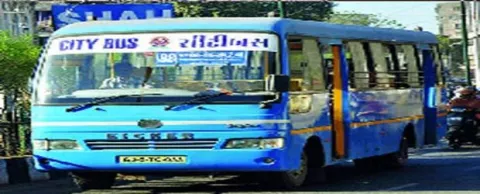
Surat, being the centre of opportunities for laborers and investors, has attracted migrants from nearby rural areas and cities. This has increasing the demand for intra-city transportation. In the year 2006, Surat Municipal Corporation’s (SMC) limits were increased from 112.28 sq km to 326.515 sq km. The expanding geography of the city requires good level of coordination and consistency to deliver transport services and manage the traffic. Surat has a bus transportation system with 291 operational routes in the city with a low average kilometer travelled per day of 0.22 lakh. The citizens in Surat have traditionally preferred personal vehicle and auto-rickshaw over public transport. This has led to a situation, where significant on-road parking is prevalent on 60% of the city roads, thereby hampering traffic movement.
The intervention
At present, Surat is implementing a city wide integrated system – Intelligent Transit Management System (ITMS), to manage diverse set of transportation needs for the city – this includes public transport and vehicles related to civic services like solid waste management, drainage, heavy engineering, emergency services etc.
ITMS is planned to bring in best-in-class operational efficiency and automation to the operational capability of the city in respect to transport. Some of the key features of the project are:
Key outcomes
Under the project, the Command & Control Centre along with Data Centre has been established and four bus depots have started utilizing DMS. The project covers 30 operational routes for bus services in the city. This has benefitted the city efficiently. This could be evident from the fact that at present, 115 BRTS buses and 200 city buses are being tracked using ITMS, where ridership of – 85,000 per day (for BRTS) and 45,000 per day (for other city bus service) has been recorded. In addition, 154 BRTS stations and more than 400 city bus stops have been integrated with ITMS. BRTS and city buses are now available with an average frequency of 8-10 minutes and there is increased information about public transit covering BRT buses and city buses, to citizens with help of mobile app and public website.
Impact
In the medium to long run, the implementation of ITMS is expected to improve public transport connectivity across the city – increased number of buses on BRTS as well as city bus routes, in accordance with demand analysis through ITMS. Increased ridership and increased usage of public transport along with reduction of travel time owing to dedicated BRT corridors managed through ITMS.
The intervention
At present, Surat is implementing a city wide integrated system – Intelligent Transit Management System (ITMS), to manage diverse set of transportation needs for the city – this includes public transport and vehicles related to civic services like solid waste management, drainage, heavy engineering, emergency services etc.
ITMS is planned to bring in best-in-class operational efficiency and automation to the operational capability of the city in respect to transport. Some of the key features of the project are:
- Enterprise Management System: to monitor operations and adherence to laid down service levels
- Automatic Vehicle Location System (AVLS): to track buses on service lines and provide alerts like route deviation, trip adherence, skipped stops, etc.
- Incidence Management system (IMS): helps streamline incidence management in cases like vehicle breakdown, accident, etc.
- Depot Management System (DMS): Manages all bus/ driver information; facilitating schedule management and allocations of the same
- PIS Management System: This is the central module, which manages all data from buses’ GPS units and pushes it to Passenger Information System (PIS)/ mobile app/ website etc.
- Command and Control Centre (CCC): provides overall management, ensure smooth ITMS functions by coordinating with relevant stakeholders – the CCC is presently operated by 10 designated/ trained personnel
- Data Centre: ITMS has its own data centre comprising of switches, servers and storage systems, which is specifically designed for the ITMS project
Key outcomes
Under the project, the Command & Control Centre along with Data Centre has been established and four bus depots have started utilizing DMS. The project covers 30 operational routes for bus services in the city. This has benefitted the city efficiently. This could be evident from the fact that at present, 115 BRTS buses and 200 city buses are being tracked using ITMS, where ridership of – 85,000 per day (for BRTS) and 45,000 per day (for other city bus service) has been recorded. In addition, 154 BRTS stations and more than 400 city bus stops have been integrated with ITMS. BRTS and city buses are now available with an average frequency of 8-10 minutes and there is increased information about public transit covering BRT buses and city buses, to citizens with help of mobile app and public website.
Impact
In the medium to long run, the implementation of ITMS is expected to improve public transport connectivity across the city – increased number of buses on BRTS as well as city bus routes, in accordance with demand analysis through ITMS. Increased ridership and increased usage of public transport along with reduction of travel time owing to dedicated BRT corridors managed through ITMS.



